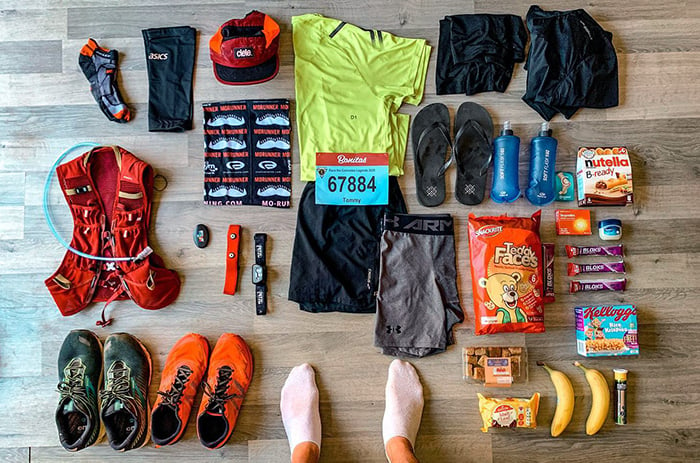Whether it’s your first 5K or your tenth marathon, race day comes with enough nerves on its own. The last thing you need is to be frantically digging through your bag or realizing halfway to the start that your bib is still sleeping in your hotel room.
Having a clear, tested gear checklist can help you stay calm and focused. So, let’s keep things simple. Here’s your complete race day packing list, plus distance-specific tips to make sure nothing gets left behind.
The basics
These are the non-negotiables. No matter the race distance, these essentials should be laid out and checked the night before:
- Race bib (plus safety pins or bib belt)
- Timing chip (if not built into the bib)
- Running shoes you’ve trained in
- Your full race outfit (top, bottoms, socks, sports bra for women)
- Watch, phone, or GPS device—charged
- Warm-up layer or throwaway clothes for the start
- ID and race confirmation if you collect the bib on race day

Fuel and hydration (before, during, and after)
Even short races need thoughtful fueling. For longer distances, a solid plan can be the difference between running strong and bonking:
- Breakfast/snack you’ve tested (nothing new)
- Water bottle or handheld for sipping before the start
- Sports drink or electrolyte tabs if needed
- Gels, chews, or whatever fuel you’ve practiced with
- Recovery snack or protein drink for post-finish
Weather backups
Conditions can shift fast, especially at early start times or during spring and fall races. Bring these just in case according to the season:
- Lightweight hat, gloves, or arm sleeves
- Light jacket or windbreaker
- Trash bag, foil blanket, or poncho for rainy starts
- Sunglasses
- Sunscreen
Extras that make life easier
These might not directly impact your pace—but they’ll definitely affect how smooth your day feels:
- Cash or card for food vendors or transportation
- Anti-chafe balm and lip balm
- Blister kit or small first-aid supplies
- Portable charger or charging cable
- Earbuds
- Towel and baby wipes for a quick cleanup
- Flip flops or recovery shoes
What to pack in your drop bag (if using one)
Some races allow a bag to be transported to the finish or stored nearby. Here’s what’s worth including:
- Dry shirt or sweatshirt
- Fresh socks or recovery shoes
- Post-race bar, banana, or recovery drink
- Your phone or car keys (if not carrying them)
- Anything that’ll help you feel human again after the finish
Final checks the night before
- Lay out every piece of your gear, head to toe
- Pin your bib on securely (or have your belt packed)
- Charge your watch and phone
- Set two alarms
- Double-check your bag, directions, and start time
Related: 9 Things to Do the Night Before Your Race
Distance-specific checklists
What you bring depends on how long you’ll be out there—and what your race plan looks like. Here’s a breakdown by distance:
5K and 10K
These short races are light on gear—but don’t underestimate comfort and convenience:
- Race outfit and shoes
- GPS watch
- Water bottle for before and after
- Sunglasses, hat, or gloves depending on the weather
- Small breakfast or snack
- Post-race dry clothes
You likely won’t need fuel during the race—but hydrate early and have a snack ready for the finish.
Half marathon
Long enough to require fueling, short enough to carry light:
- 1–2 gels or chews (depending on pace and needs)
- Fuel belt, shorts with pockets, or handheld storage
- Chafe balm for hotspots
- Weather-appropriate accessories
- Recovery drink or snack in your drop bag
Don’t try new fueling strategies on race day—use whatever worked during long runs.
Marathon
This is where logistics start to matter just as much as pace:
- 3–5 gels or fueling products (or more if you’re out there longer)
- Electrolyte tabs, especially in heat
- Plan for how and when you’ll hydrate (carry or aid stations)
- Full body chafe protection, tape for nipples if needed
- Recovery shoes and clothes for your drop bag
- Sunscreen and layers depending on the forecast
Label everything and stash backups. You don’t want to rely on aid stations alone if you’ve trained with something specific.
Ultra
Think in stages: what you’ll need at the start, what to access mid-race, and what will matter at the finish. Be ready for everything:
- Hydration vest or pack
- Headlamp or flashlight with spare batteries
- Full nutrition plan: real food, gels, salt, caffeine if needed
- Extra socks, shirt, and shoes in your drop bag
- Emergency items: blister care, pain relief, anti-chafe, whistle, foil blanket
- Poles (if allowed and practiced with)
- Weather gear: windbreaker, gloves, hat, buff
Most ultra events come with a list of mandatory gear—and organizers will often check it before the start. Review those requirements in advance and pack accordingly. It’s not just about safety—it’s about being self-sufficient when aid stations are miles apart and conditions can change fast.
Related: Avoid These 5 Sneaky Gear Mistakes on Race Day
Packing your race gear is a part of the ritual. The more dialed-in you are the night before, the less you’ll stress when the start gun goes off. Stick to what you’ve trained with, lay it all out early, and don’t overthink it. When everything you need is in place, all that’s left is to run.
Good luck out there—and may your race feel strong, steady, and exactly how you trained for it.








